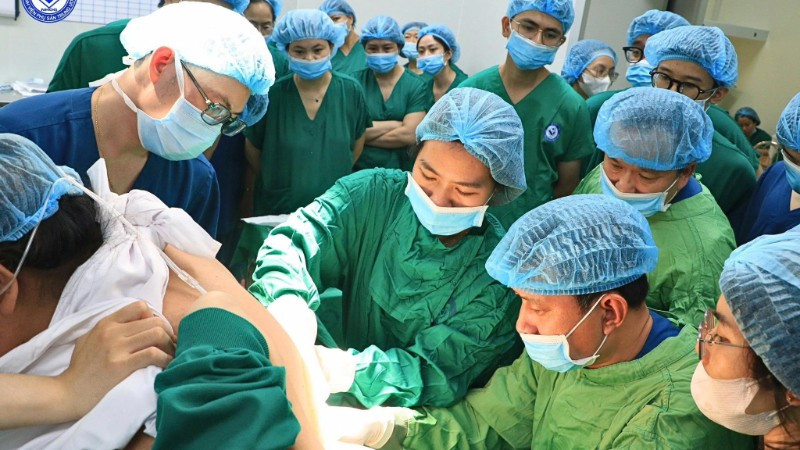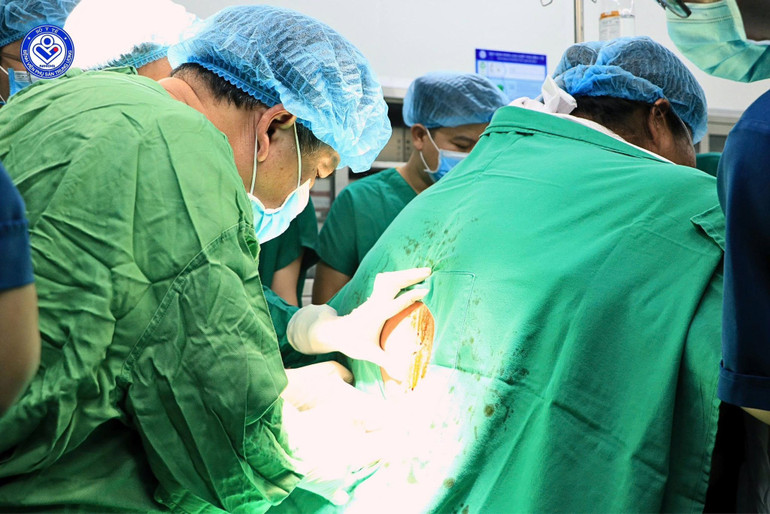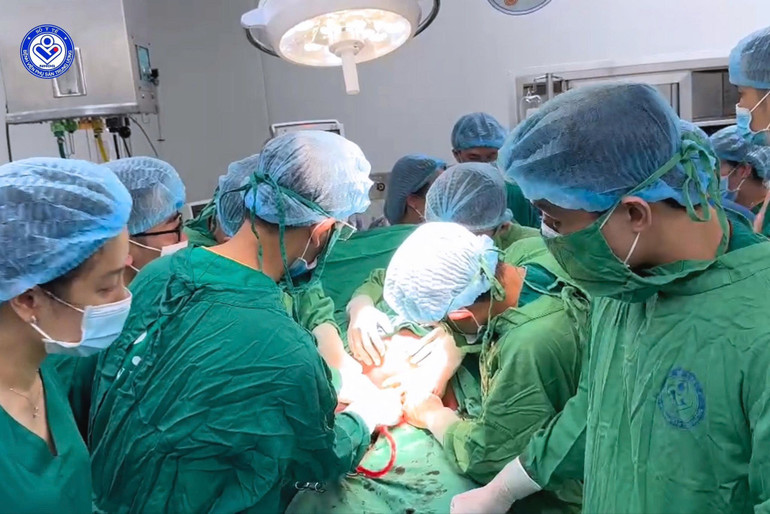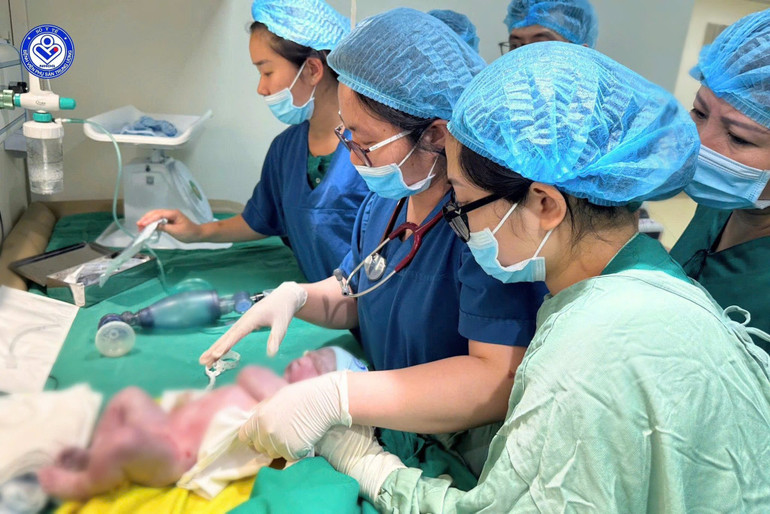
Brainstorming with anesthesia and resuscitation plan for pregnant women
The pregnant woman NTD (28 years old, from Phu Tho ) had a metabolic disorder that led to uncontrolled weight gain, her weight before pregnancy was about 140kg and she gained 38kg during pregnancy. With the large weight and pre-eclampsia and diabetes, normal delivery was almost impossible. Choosing a cesarean section also carries a series of dangerous risks in anesthesia, surgery and post-operative resuscitation.
The pregnant woman was transferred from Vinh Phuc Obstetrics and Pediatrics Hospital to the Central Obstetrics Hospital in a high-risk condition for both mother and fetus.
Realizing that delaying the cesarean section could worsen the prognosis for the mother and fetus, the anesthesiologists and obstetricians urgently consulted and decided to perform an emergency cesarean section. At the same time, the doctors developed a detailed and rigorous plan, ready for two scenarios including regional anesthesia (spinal anesthesia or epidural anesthesia) or endotracheal anesthesia.
On August 13, the team decided to perform a cesarean section on the pregnant woman.

Master, Specialist II Doctor Bach Minh Thu - Head of the Department of Surgery, Anesthesia and Resuscitation said that for obese patients, the thick layer of fat causes loss of anatomical landmarks, the distance from the skin to the subarachnoid space is too large, the existing anesthetic needle is almost not long enough, so the risk of regional anesthesia failure is very high even with the support of ultrasound.
"When using an ultrasound machine to determine the anatomy, we recorded that this distance was up to more than 11cm - exceeding the maximum length of the anesthetic needle by quite a bit. Therefore, after spinal anesthesia was no longer possible, the team quickly switched to the endotracheal anesthesia plan that had been fully prepared in advance," said Dr. Thu.
However, anesthesia is also difficult and has many potential dangers such as not being able to ventilate after the mother has been anesthetized and is no longer able to breathe on her own; next is the difficult prognosis of endotracheal intubation and the risk of not being able to place an endotracheal tube using conventional simple methods.
Especially in obese pregnant women, the ability to store oxygen is very poor, with the risk of rapid and severe hypoxia. Therefore, just one mistake or difficulty during anesthesia can lead to severe hypoxia for both mother and fetus, endangering their lives.
For the above reasons, the anesthesia team conducted a careful and thorough pre-anesthesia examination, carefully assessed the patient's respiratory status, airway, and other related issues to be able to come up with an effective and safe anesthesia plan.

At the same time, all equipment, machinery and medicines are prepared for possible situations such as camera light system, endoscope light, Igel mask system, endotracheal tube, ... and even tracheostomy plan.
At the same time, the doctor must calculate the dosage of anesthesia drugs based on the ideal height and weight to ensure enough drugs for deep anesthesia and sufficient muscle relaxation to facilitate endotracheal intubation, while also considering avoiding hypotension and affecting hemodynamics - which can easily occur in obese pregnant women undergoing anesthesia.
The team performed the intubation procedure according to the strategy of "not losing the airway", optimizing the position and maximizing oxygen reserve before anesthesia to reduce the risk of hypoxemia for the mother and fetus - a common complication in patients like this.
Special cesarean section
During the surgery, specialist II Dang Quang Hung - Deputy Head of the Department of Obstetrics and Gynecology - who directly performed the surgery, said that the most difficult part of the surgery was the very thick abdominal wall, making it difficult to access the uterus and remove the fetus. The sagging abdominal fat tissue made the surgeon's operations much more difficult.
On the background of hypertension and diabetes, the risk of surgical site infection and postoperative respiratory complications also increases significantly. During surgery, due to the large abdominal fat mass and the fetus compressing the diaphragm, the lungs are pushed up, making it difficult to expand, easily collapsing, and there is a risk of cardiopulmonary complications.
The surgery therefore requires a smooth coordination between anesthesia and surgery to quickly and safely deliver the fetus, while "releasing" the hemodynamic burden on the mother.

After nearly 1 hour, the surgery was successful. The baby boy weighed 3.4 kg, was rosy, cried loudly, and was transferred to the Neonatal Center for monitoring immediately after birth. However, the mother, although hemodynamically stable, still had to continue to face many respiratory risks, so she was closely monitored in the post-operative room.
Master, Doctor Hoang Thi Ngan - Doctor of Surgery, Anesthesia and Resuscitation shared that in cases of obesity, the process of coming out of anesthesia, weaning off the ventilator and removing the endotracheal tube also needs to be calculated and controlled closely.
With a large body weight and high fat ratio, the chest capacity is limited, the mobility of the chest is poor, and the diaphragm is pushed up, making the patient's oxygen reserve very poor, and the risk of collapsed lungs and reduced ventilation after extubation is very high.
In the post-operative room, the patient D. continued to be monitored with a ventilator, then used muscle relaxants and extubated according to the predetermined procedure and plan. Immediately after extubation, the patient was supported with non-invasive positive pressure ventilation and instructed in breathing exercises to optimize blood oxygenation and avoid lung collapse.

During the monitoring process, the pregnant woman responded well and met the conditions and was transferred to the Emergency Resuscitation Department for further monitoring.
Doctors recommend that women who are obese or have metabolic disorders should be examined and counseled before pregnancy, develop a plan to control weight, blood pressure and blood sugar, and have a reasonable diet and lifestyle. During pregnancy, it is necessary to have regular check-ups on schedule, follow nutrition and exercise according to professional instructions and consult a doctor early if there are any unusual signs (edema, rapid weight gain, headaches, visual disturbances, high blood pressure, etc.).
Being examined and consulted from the beginning as well as promptly transferring to a specialized facility when there are risk factors will help ensure maximum safety for the mother and newborn.
Source: https://nhandan.vn/ca-phau-thuat-dac-biet-lay-thai-cho-san-phu-nang-178kg-post900954.html























![[Photo] Firmly marching under the military flag: Ready for the big festival](https://vphoto.vietnam.vn/thumb/1200x675/vietnam/resource/IMAGE/2025/8/15/86df2fb3199343e0b16b178d53f841ec)



![[Photo] The special solidarity relationship between Vietnam and Cuba](https://vphoto.vietnam.vn/thumb/1200x675/vietnam/resource/IMAGE/2025/8/15/5f06c789ab1647c384ccb78b222ad18e)
![[Photo] President Luong Cuong receives Finnish Ambassador to Vietnam Keijo Norvanto](https://vphoto.vietnam.vn/thumb/1200x675/vietnam/resource/IMAGE/2025/8/15/0f783d6b0f0344ac8b7396962fd8da69)
![[Photo] Binh Khanh Bridge Ho Chi Minh City is ready to reach the finish line](https://vphoto.vietnam.vn/thumb/1200x675/vietnam/resource/IMAGE/2025/8/14/b0dcfb8ba9374bd9bc29f26e6814cee2)




































































Comment (0)